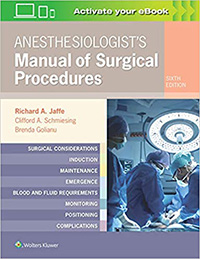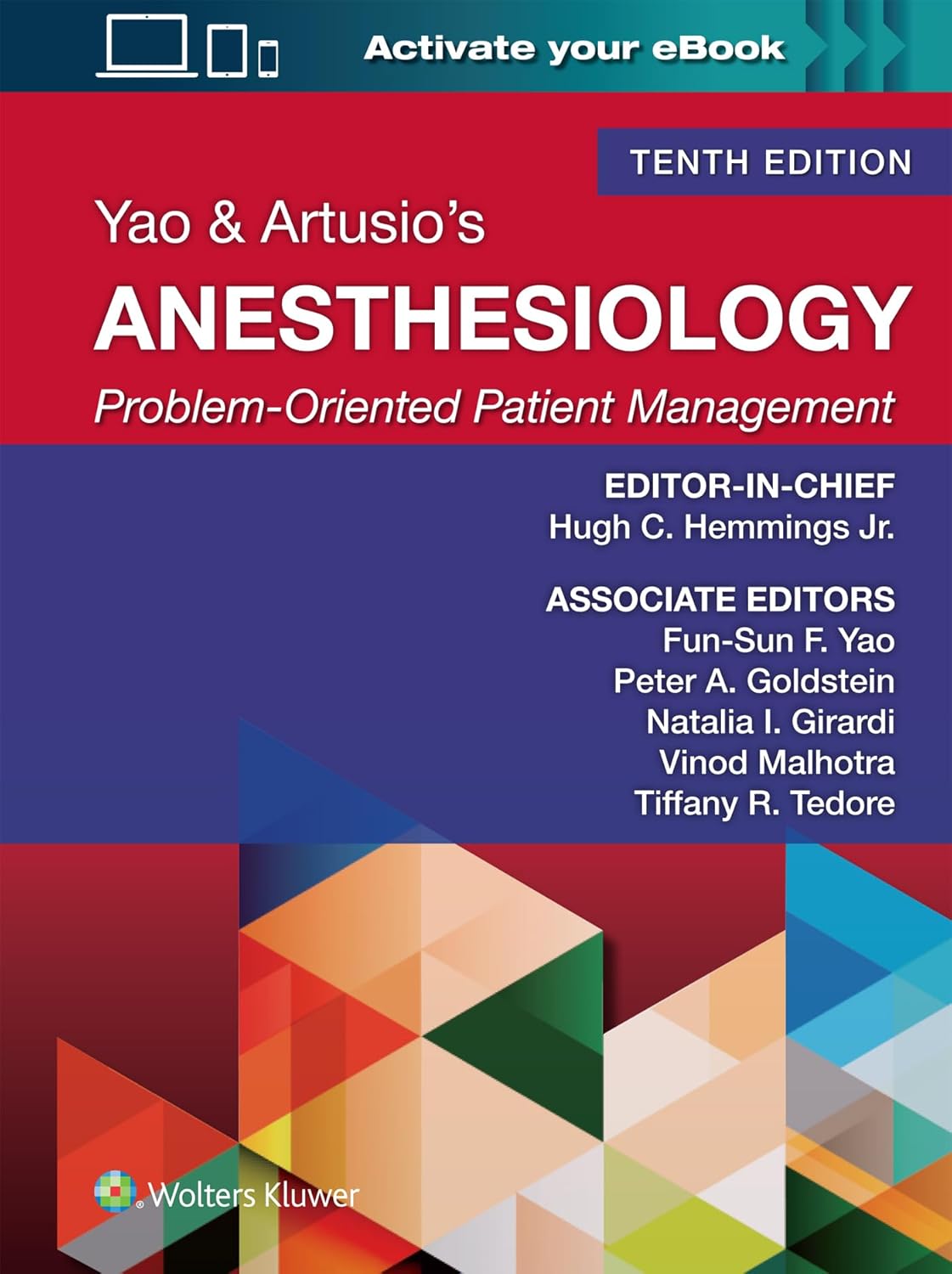
Edition 6 (2019)
Richard Jaffe, Clifford Schmiesing, Brenda Golianu
Covering both surgical and anesthetic considerations, Anesthesiologist’s Manual of Surgical Procedures, Sixth Edition, is an essential resource for formulation of an anesthetic plan and perioperative management of patients. All chapters are written by both surgeons and anesthesiologists, giving you a detailed, real-world perspective on the many variables that accompany today’s surgical procedures.
Presents preoperative, intraoperative, and postoperative anesthetic considerations in a clear, templated format, summarizing all courses of action in easy-to-read tables.
Describes what the surgeon will likely be doing, variants of the procedure or approaches, patient population characteristics, and details of the procedure including positioning, length of procedure, postop care, and more.
Features a full-color design to enhance readability of the tables and clarity of the illustrations.
Updates to this edition include a new, heavily illustrated chapter overviewing regional blocks and new appendices covering individual components of enhanced recovery (ERAS) protocols and intraoperative use of transnasal humidified rapid-insufflation ventilatory exchange (THRIVE); as well as new, rapidly accessible tables and figures set on the inside back cover reviewing useful, but easily forgotten facts and dermatomes.
An ideal reference for anesthesiologists, anesthesia residents, and CRNAs.
Edition 1 (2017)
Linda Aglio, Richard Urman
Divided into twelve sections that cover the entirety of anesthetic practice, this is a case-based, comprehensive review of anesthesiology that covers the basics of anesthetic management and reflects all new guidelines and recently developed standards of care. Each chapter of Anesthesiology: Clinical Case Reviews begins with a specific clinical problem or a clinical case scenario, followed by concise discussions of preoperative assessment, intraoperative management, and postoperative pain management. In addition to residents and fellows, this book is written for practicing anesthesiologists, student nurse anesthetists, and certified registered nurse anesthetists (CRNAs).

Edition 1 (2019)
Adam Adler, Arvind Chandrakantan, Ronald Litman
Pediatric anesthesiologists will encounter numerous challenges when caring for children as their work involves more than simply adjusting drug dosages and equipment for smaller patients. In response, this practical book provides clinical guidance in an easily-accessible and digestible question-answer format. Case Studies in Pediatric Anesthesia reviews the entire breadth of pediatric anesthesia and pain management, taking a case-based approach. Each chapter commences with a clinical case or scenario, guiding the reader through a tailored discussion. The chapters review the pathophysiology, anesthetic techniques and surgical and perioperative considerations. High quality tables and figures feature throughout to help solidify key concepts. The chapters are prepared to be read in isolation and for reference when appropriate. Case Studies in Pediatric Anesthesia is aimed at anesthesiologists of all levels, from the trainee on their first pediatric rotation, to the pediatric fellow preparing for boards examination to the seasoned clinician.
Edition 1 (2019)
John Butterworth, David Mackey, John Wasnick
A clinically relevant, case-based review of anesthesiology – based on the field’s cornerstone text
Includes link to video clips demonstrating key procedures
Essential for written and oral board preparation, here is a new case-based companion to Morgan and Mikhail’s Clinical Anesthesiology, Sixth Edition textbook. The book includes approximately 300 brief case descriptions, with each case followed by a series of board-style Q&A. These cases are organized to match the content of the parent text to facilitate side-by-side study. With case-based learning now pervasive in training for all medical specialties, especially anesthesiology, Morgan & Mikhail’s Clinical Anesthesiology Cases fills a void in medical publishing. This unique resource is also valuable as a clinical refresher before the Operating Room.
Edition 3 (2021)
Robert Holzman, Thomas Mancuso, Joseph Cravero, James DiNardo
This book functions as a workbook for consultants in pediatric anesthesia. Based on a curriculum developed at the Boston Children’s Hospital Department of Anesthesiology, the content illustrates the breadth and depth of the practice of pediatric anesthesia.
Organized into two parts, the book seeks to provide a sense of progression and feedback using clinical scenarios to aid the medical professional in developing autonomy, while preserving the availability of expert level discussion. Each chapter features self-assessments in question and answer format, and encourages the reader to be creative in their responses by invoking not only their clinical knowledge, but their philosophical views of pediatric anesthesia practice as well.
Practical and accessible, The Pediatric Anesthesiology Review is an essential resource for those looking to attain proficiency, expertise, and mastery in pediatric anesthesiology.

Edition 10 (2025)
Hugh Hemmings, Fun-Sun Yao, Peter Goldstein, Natalia Girardi, Vinod Malhotra, Tiffany Tedore
Prepare for the oral and written boards with this case-based, easy-to-use review tool from Drs. Hugh C. Hemmings Jr., Fun-Sun F. Yao, Peter A. Goldstein, Natalia I. Girardi, Vinod Malhotra, and Tiffany Tedore. Yao & Artusio’s Anesthesiology: Problem-Oriented Patient Management, Tenth Edition, contains more than 60 real-world cases accompanied by questions that conform to the four areas of questioning on the oral boards, reinforcing step-by-step critical thinking about today’s surgical anesthesia and patient management. This core text has been thoroughly revised to bring you up to date with all that’s new in the field.
Features a problem-based approach to emphasize critical thinking, collaborative decision making, and problem-solving skills
Uses a consistent chapter format that includes presentation of a case; questions on medical disease and differential diagnosis, preoperative planning and preparation, intraoperative management, and postoperative management; and complete answers and discussion of the case
Contains new and updated content throughout, including topics such as coagulopathy and major and complex spine surgery, as well as updated references for further study and clarification
Allows you to repeatedly work through key considerations that reinforce logical, critical thinking about patient management

